Hal Koerner has won some of our sport’s biggest races and set speed records on a few of our country’s most iconic trails. From fast 50k’s to long, hard 100 milers, Koerner has been one of ultrarunning’s most versatile champions. He’s also a dad, husband, race director, and running-store owner who finds the time necessary for training at the elite level. A veteran of over 130 ultramarathons, Koerner even graced the December, 2013, cover of Outside magazine.
In July, 2014, Koerner published his first book, Hal Koerner’s Field Guide to Ultrarunning: Training for an Ultramarathon, from 50K to 100 Miles and Beyond. I caught up with Hal on two occasions from his home in Oregon to discuss recovering from knee surgery and establishing life-running balance with two kids, a store, and a professional running career.

Hal Koerner running the 2014 Speedgoat 50k pre-knee surgery. Photo: Paul Nelson
iRunFar: A few years ago, Ashland, Oregon was in the news a lot as a running Mecca, or a petri dish, if you will, for running success. The press has died down, as it does, but is Ashland and your store still a hotbed for the next big ultrarunner?
Koerner: Some of it’s fallen off maybe, but we still seem to attract those people who are interested in getting into the ultra scene and we still have a lot of fast people here. I think Timothy Olson coming on the scene, running his first 50 miler in 2010, and then winning Western States 100 shortly thereafter proves anything can happen with a little bit of passion and the right elements thrown together. There’s a lot of that here.
We’ve still got people like David Laney who’s living here because he loves the area and it’s a good place to train.
I have a couple runners coming back to work that are ex-SOU [Southern Oregon University] grads who’ve shown a lot of potential. I also have a kid, Eric Avila, who runs for Hoka, that ran a 3:56 mile last year. That’s not just a sub-four-minute mile, that’s super fast. It’s not necessarily that he’s going to be the next ultrarunning star, but I’ve always thought that the main reason there was so much success was because we all fed off each other. No matter what anyone was doing, there were a lot of examples of dedication and motivation. I think it takes synergy of all those different pieces to get going again and we definitely have some of that. I’m also looking to draw off that, too, in coming back from my knee injury.
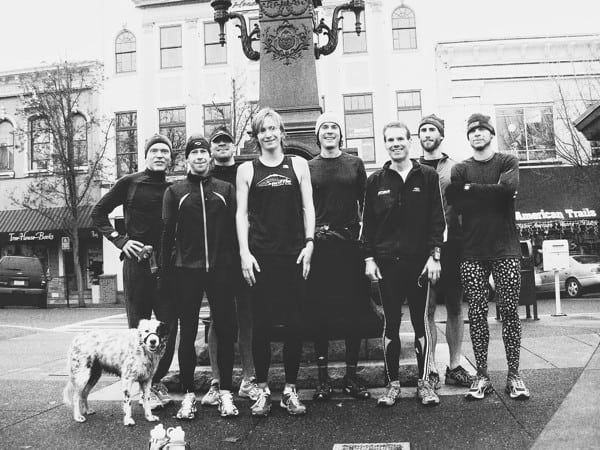
A 2008 Ashland, Oregon group-run photo. Can you identify all the icons? All photos courtesy of Hal Koerner unless otherwise noted.
iRunFar: What exactly happened to your knee?
Koerner: Training for UTMB [2014], my right knee just started giving out, stability-wise. I was trying to up my training before going to France and somehow tore the meniscus in my right knee. It probably happened in June, but I first noticed it trying to put shoes on people’s feet at the store. When it was bad my whole knee would swell up and I could hardly extend my leg. I thought it was my hamstring or the attachment for a while. It didn’t lock, but it was extremely painful on any extension and I couldn’t squat or stretch my quads for like four months.
I wasted a bunch of time before I finally got an MRI. It turned out to be a posterior tear. My doctor used to be the [Los Angeles] Rams and Lakers doctor. He’s got pictures of Magic in his office and he’s worked on Orel Hershiser. He was great and told me he’d treat it like it was his own knee. When I came out of surgery he said it was clean and that they had to take 30 percent of it out. Then he said, “But I wouldn’t run on pavement anymore.”
Afterward the amount of atrophy was bad. Visually, from the outside the wounds healed in a week and within three days I could actually stretch my quad for the first time since it happened. My doctor didn’t really prescribe rehab. I just got back to training the best I could and had to ask myself, Are you going to change your life and what you love to do because of this? Like, tomorrow I’ll just stop running and pick up something else. I’ve got a friend who says, “I’ve spent my whole life deciding that I like running, I stopped liking biking, I stopped liking skiing…” And that’s where I’m at now—I’m a runner.
I was recently at The North Face Athlete summit with all these Olympians and champion extreme skiers. They’re in their twenties and blowing out knee after knee. But you know what? They just rehab it and go again. That might seem cavalier and brash but at the same time doctors are here to fix those types of things.
iRunFar: Do you think meniscus surgery is inevitable for a seasoned ultrarunner, or in your case, someone who’s completed more than 130 ultramarathons?
Koerner: It could have been a natural wear-and-tear type of thing, but I don’t even know for sure when it happened. It could have been from one too many beers one night or a little tweak on a long run. It’s just like anything else, though, car accidents aren’t going to stop you from getting in your car tomorrow to drive to the supermarket. The benefits of running outweigh all the risks.
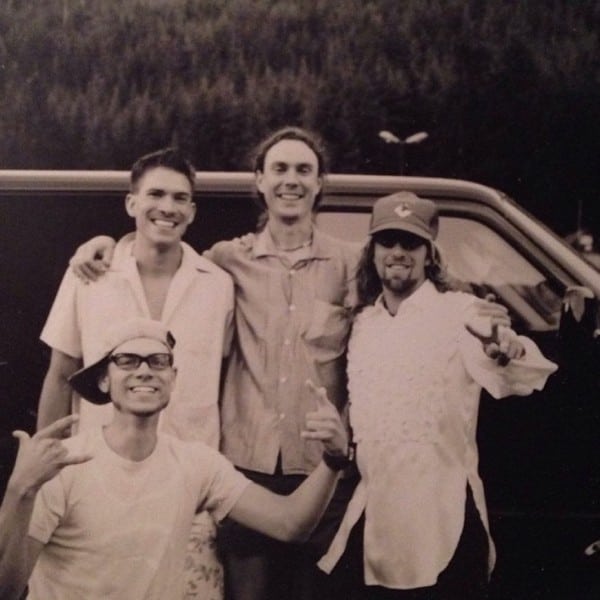
Hal and friends at the 2003 White River 50 Mile. Can you identify everyone?
iRunFar: Your return to 100-mile racing post-surgery was at the Umstead 100 Mile in late March, 2015. How’d that go?
Koerner: Umstead was a slap in the face. I did the Grand Traverse skimo race with Pete Walstrom the week before, thinking I could fly to North Carolina and run this 100 miler after. We thought we’d be done with the Grand Traverse in like eight hours, but it ended up being a 14-hour slog where we ran out of water for the last five hours.
Anyway, so the first 50 miles of Umstead, I got lost and then to make up for that I started running really hard. Then my quads blew bad. It’s almost like running on pavement there, it’s crushed granite, wide enough for a car, and no climbing so it’s super fast. I was trying to gauge off a guy running the 50 miler hard. I wanted to come through in like 6 hours, 15 minutes and then see what would happen with the next 50, but then around 50 miles my left side started blowing up bad. At 50 I was wondering if I should even keep going for the next 50 miles or not. Eventually, I knew I was not where I needed to be, so I stopped.
Luckily the knee came back okay. There was no issue with the meniscus in recovering, but I’ll tell you I couldn’t sit down after. I felt like I had just run my first marathon. You know where you go to sit down and you get half way down to the chair and then you fall into it sort of thing. It was bad for a whole week.
That was the furthest I had run in over a year. I had to step back and wrap my head around it. Be realistic, that is. That is where we were. That is how bad I should have felt. My legs haven’t felt anything like that bad in years. It turned out to be a pretty good race. It’s a good race. I mean, I still think with the right training it’s a sub 13-hour 100-mile course for sure. I still think 13 hours on a trail course is still kind of my goal maybe the next couple of years.
iRunFar: Was that disheartening?
Koerner: This past April, I was headed to run the Pear Blossom Run, which is our little mile road run here in Medford. I dropped [my wife and daughter,] Carly and Nyla, off at the airport and decided to get some pancakes beforehand. So, I go into this diner off the highway called Black Bear. This older guy walks in and he’s dressed like he’s going on a safari. He comes over to me and says, “I know you.” I can’t place this guy, so I start to shake my head, and he says, “You won Western States.” I was like, “Well, I guess you do know me then.”
So this 65-year-old guy sits down and starts to tell me he’s been running ultras since the ’80s and that he used to run with Ann Trason. Then how he got old and the knees gave up. He said, “I wasn’t winning anymore and it just wasn’t any fun. You get a couple injuries and don’t come back from them very quick. Then you train really hard and something else happens. You almost get back, but something else happens. Then you don’t even wanna’ try to train anymore because it takes so long to get back from injury.”
We had an hour conversation about how he quit the sport. There were moments where it was this weird aberration or vision of where I’m headed. I guess I’m lucky I live in southern Oregon. What came out of it was that both our lives revolved around trail running and ultrarunning and how much we loved the endurance aspect of things. But, the whole gist of the conversation really solidified the fact that, though I have been disheartened, there are reasons to get back out there. There are events and challenges for me to go do. I’m just trying to figure out what those are.
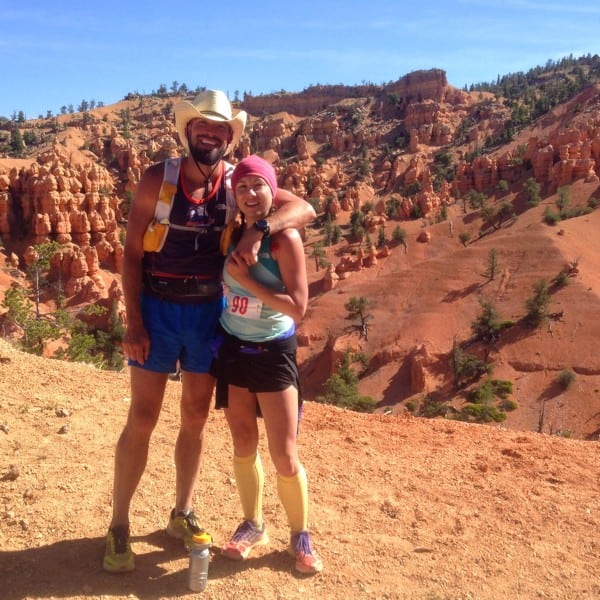
Hal and his wife, Carly, at Bryce Canyon in Utah in 2014.
iRunFar: You recently had your second child, a boy named Izaak. Congratulations. How has his entrance into the world been?
Koerner: Izaak is doing well. It took us a while to fall back into the rhythm of raising an infant. Luckily, Nyla is beginning to sleep through the night, because that is really where the double team begins to wear on you. We never really figured out how to transition her sleeping habits from a baby to a toddler so perhaps the second child will give us a chance to nail it.

Izaak and Nyla.
iRunFar: Is it exponentially harder with two?
Koerner: I think that, for the first couple years, it is exponentially harder because one child commands pretty much all of our attention. It was hard for me to think about where I could come up with the energy to care for and handle another one. I’m still not sure where the energy comes from. I never thought I would say this, but I am grateful for four hours of sleep a night. I rely on my daily runs to help energize me, but it is hard to feel that I am recovering and building muscle when I don’t think I ever hit meaningful sleep patterns. Oh well, I have gotten pretty lazy in my old age so the more hours I have awake to get things done, the better.
iRunFar: How do you manage high-level training with being a father of two?
Koerner: I don’t know how you can maintain a high level of training with two kids under two and be an involved parent. I would like to know how it’s done. I’m not sure I could do it, to be honest with you, either. I am going to rely on something I said when I opened the store and was trying to run crazy mileage, in that I thought it helped reign me in from overtraining. I don’t think I am in that category wholly, nor am I 29–boy do I wish I was–but really this has been a year of managing expectations. I was just reminded the other day from one of my doctors that my knee is still healing, up to a year after surgery, so that is something I have to keep in perspective. I’ve done and attempted even more on a less-than-perfect knee this year and I know that once I am healthy, things will begin to click into place for me. Being more consistent and having faith in my abilities to give that extra effort will be very rewarding.
Finding a nice balance is the hard part. What is too much? Obviously, ultrarunning takes up so much time. I got away from ultrarunning a little bit with the baby and then even more with the knee. I’m figuring out how to come back and prioritize my time. I’m glad that happened to me and now I have that perspective. I now feel more like the average ultrarunner for sure. “Where am I going to find the time to do this? How am I going to schedule and plan this?” I’ve never had to look at it from that perspective. You know most people don’t have a block of three hours in their day to just go for a run, so finding that time and figuring out how to manage that has been tough, trying to keep all that together and switch your perspective.
As I got a bit older and the performances didn’t come as easy, I went down this path in my head that, Maybe I need to do a little bit more, a little bit harder. Now all of a sudden I’m going to have to start from scratch and redesign everything, and that’s like trying to teach an old dog new tricks. I got an old dog–she’s run a lot of miles with me–but she doesn’t do anything new.
With that said, this affords me the opportunity to spend more time with my kids. If my racing has to give a little in that aspect, it’s a good thing. It makes me appreciate what I have, what I had, and what most people are longing for. This makes me a better person.
iRunFar: So, what does your racing future look like?
Koerner: You know I still love running 100 milers, but with the knee and the little one, you know how it goes, to be competitive at a 100 miler you have to be somewhat careless. You have to be able to redline for a while. So, I need to be sure my knee is able to allow me to be careless. That’s what I want to get healthy for.
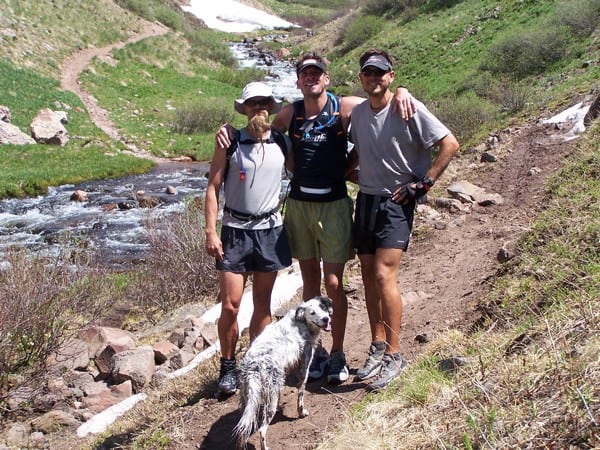
Hal training with friends for the 2005 Hardrock 100, where he came in third.
iRunFar: That’s interesting. There is a moment in a 100 miler where you have to say, “Screw it, I’m no longer gonna’ worry about any of this pain, I’m just gonna’ hammer.” I was witness to you doing that at your first Western States 100 win.
Koerner: Yeah and since it’s the end of the race, you’re gonna’ do that with bad form or weird twinges here and there. Hopefully you have the confidence to say, Oh it’s just this, or a little something here, and not think that you’re setting yourself back or tearing my meniscus more or whatever it is. And that’s a hard thing to get out of my head now. I have this frayed area in my knee. Am I gonna’ hammer it some more or peel off a little more meniscus? What am I going to do? Getting that out of my head is the hardest thing to do.
iRunFar: I’ve always been curious about your preparation for your 2012 Hardrock 100 win. You used a Hypoxico altitude tent, right?
Koerner: I was like a mad scientist. I was like, “Let’s just live at 11,500 feet the second day in.” In the past I would have just driven to Silverton, Colorado, and slept at 11,500 feet anyway. The main difference was running around here I was so much lower training around town, at 2,000 feet. I was like, “Oh my god.” I was running on another level.
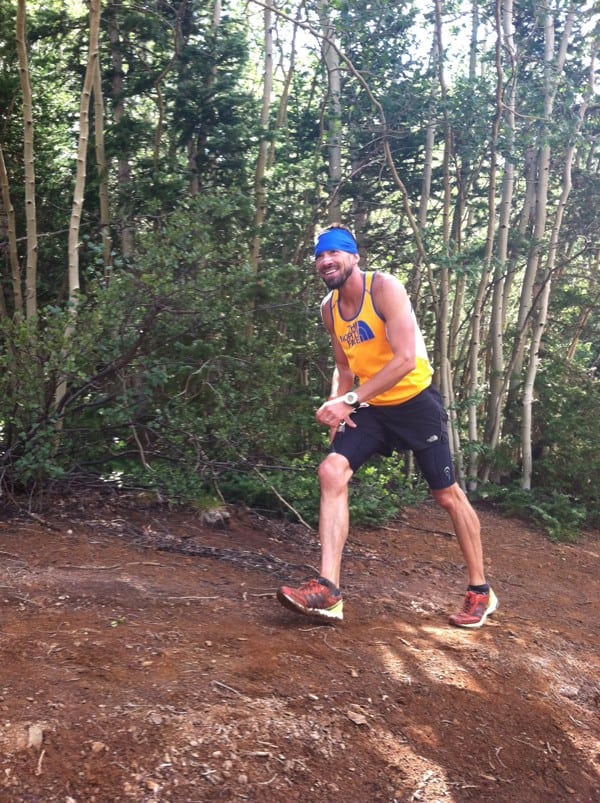
Hal Koerner on his way to winning the 2012 Hardrock 100. Photo: iRunFar/Meghan Hicks
iRunFar: How much benefit do you think the altitude gave you? Like 10 percent?
Koerner: Oh no, it was more like a 20-percent increase in performance. It was huge. There is also a psychological component, too, where you get so much confidence from using it. It did feel like it wore off on the last few climbs of the race, though.
iRunFar: What do you think about the ultrarunning growth spurt?
Koerner: Ultrarunning for me is still like 17 people standing at the start line of the Bear 100 Mile. As much as winning a bigger event is pretty cool, part of me just likes being one of 17 people standing in the woods, “Okay, let’s go run this killer course for 100 miles.”
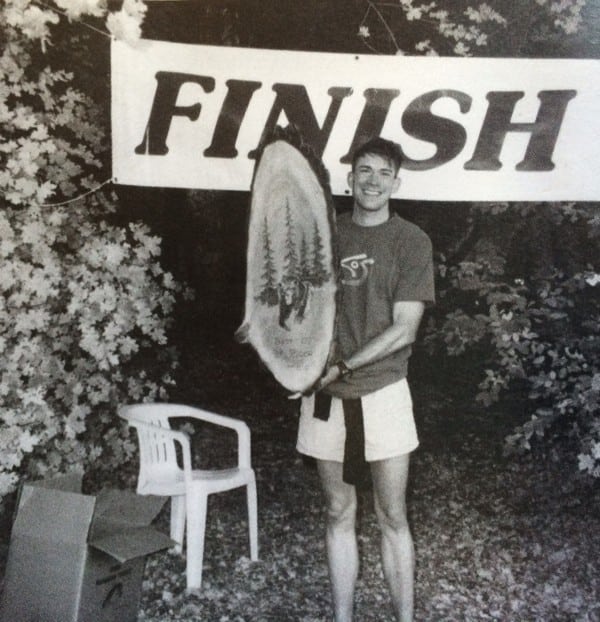
Hal Koerner after winning the 2001 Bear 100 Mile.
iRunFar: What is left for you to do?
Koerner: I’m right in this sweet spot. I’ve done a lot of things with my ultrarunning and I’ve done a ton of miles, so I’ve been having a hard time picking out the next thing for me to do. Even last year I was still trying to figure this out. UTMB was that one thing, for me, that I really wanted to nail. It didn’t have to be a podium, but I just really wanted to nail it. But, last year just wasn’t that year for me with the knee going bad.
Do I want to go run Western States again? I don’t know. Why? Do I want to go run Hardrock again? Well, sure, but when is that timing going to work again? I was dealing with that and then my knee was bad and I tried to get some training in. All of this has been a supreme test, but at the end of the day, I get to still call Ashland home and I get to walk into the one of the coolest jobs in the world.
iRunFar: You recently finished your first 100 miler since your knee surgery. How’d the race go for you?
Koerner: Arkansas Traveler 100 Mile was a good test for me. I was in the battle and I really missed that. The race was filled with a lot of talented runners. I felt good early and once I found some good footing–because the course is filled with a lot of rocky, uneven terrain–I fell into flow that allowed me some confidence through the midway point. I would say that is when my limited training and my weak knee started to wear on me. That and a dominating performance from Wesley Hunt. I really wish I had a little more in me to get over the hump of having him blow by me at mile 70 because I think we could’ve rolled some of the last runnable miles pretty well together.
iRunFar: How have your running plans changed? What’s in your running future?
Koerner: I’d like to run the Long Trail in 2016, something like four days. Maybe Bighorn 100 Mile or Cascade Crest 100 Mile, or even Western. I’ve always wanted to run the West Highland Way, that time of year sounds lovely in Scotland. There will always be this part of me that begs to jump into something last minute, and these days there are countless opportunities.
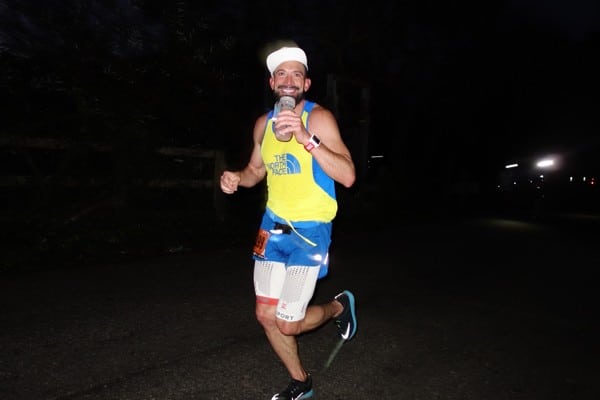
Hal at the 2015 The North Face Endurance Challenge 50-Mile Championships. Photo: iRunFar/Meghan Hicks
